Homemade Udon Noodles are surprisingly easy and fun to make, and yield amazing results. They only require 3 basic ingredients, and the finished results can be enjoyed in countless delicious ways.

(This recipe was originally published in November 2016, but was updated with new photos and content in 2023).
Udon noodles are a type of thick wheat noodle used in Japanese cuisine. They can be served hot or cold, in soups, dipped in sauces, stir-fried, and more. Udon can also be used in "shabu shabu," or Japanese hot pot, and I've even enjoyed them in Chinese hot pot.
Udon noodles are different from other Japanese noodles such as ramen (thin and chewy) and soba (thin and made with buckwheat flour). The most obvious difference is their thickness. These fat, chewy, slippery noodles are made with a very firm wheat dough which is notoriously difficult to knead by hand. In Japan, udon dough is usually kneaded with feet instead of hands.
Yes, you read that right. Traditionally in Japan, udon noodle dough is kneaded using feet instead of hands. By applying your entire weight by standing on the dough and repeatedly stepping on the dough, it will be easier to get it to the desired texture.
Make sure to place the dough in a large sealable plastic bag with a towel folded around it, and use sock-covered feet for the most sanitary results. Even kids can help with this step!
Although you can purchase udon noodles dried (less preferable), frozen (pre-cooked), or refrigerated (pre-cooked), making fresh homemade udon noodles is considerably easy (and fun) and yields the best results. They only require 3 ingredients and no special tools!
Ingredient notes

- Flour: All-purpose (plain) flour has the ideal protein content to made homemade udon noodles, usually about 10-12%.
- Water: Tap water in Japan is soft water. In the US, you may have hard water which isn't ideal. Use filtered water for better results. It's very important not to add too much water to the dough. It's meant to be a hard dough (which is why you knead with your feet). Add JUST ENOUGH water to barely saturate all the flour and bring it together into a somewhat dry dough. It will come together more as you knead with your feet, and become smooth and elastic.
- Salt: The salt content is really important in making homemade udon noodles. It helps tighten the gluten and harden the dough, which is necessary to get the right texture. Don't worry, as much of the salt will dissolve into the water as the noodles cook.
How to make it
Combine the flour and salt in a large mixing bowl, stir, then add water. Use your hands to mix until the dough starts to come together in shaggy mass (PHOTOS 1-2).

Start to firmly press and knead the dough, incorporating the loose flour until there’s none left. If necessary, add a little more water, 1 tablespoon at a time, until you can incorporate all of the flour. The dough should be very firm and still seem a little dry.
Form the dough into a ball (PHOTO 3) and place it inside a large Ziploc bag (PHOTO 4). Seal the bag leaving a small air gap at one end so so it doesn't pop when you step on it.

Kneading instructions
Loosely wrap the bag in a kitchen towel and place it on the floor. Step on the bag with the dough inside and use your weight to flatten the dough.
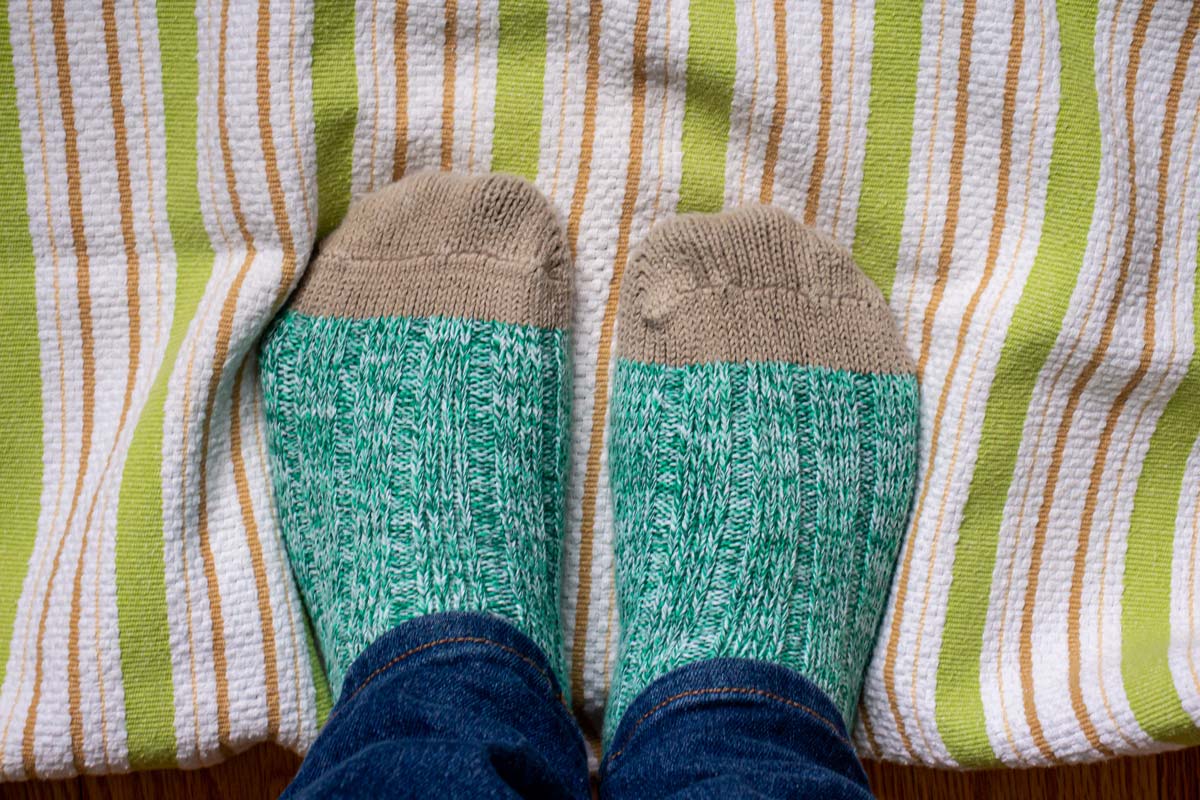
Use a rolling motion with your feet going from your heels to your toes. Step on the dough about 50 times, rotating your body a few times to step evenly over all the dough. It will flatten out inside the bag.

Carefully remove the flattened dough from within the bag (it may be a little stuck but just gently pull the plastic away). Fold the dough into thirds and then fold it in half to make a square (PHOTOS 5-6).

Press to gently flatten, and then return the dough to the bag.
Repeat the process of kneading with your feet (about 50 steps each) and then folding the flattened dough 2 more times. It should be a lot softer and more pliable than before.
Remove the flattened dough from the bag after 3 times of kneading with your feet. Fold the edges underneath to form it into a large smooth ball of dough (PHOTO 7). Return the ball of dough to the Ziploc bag (PHOTO 8), seal it and let it sit at room temperature for 2 hours in summer or 3 hours in winter to allow the gluten to relax.
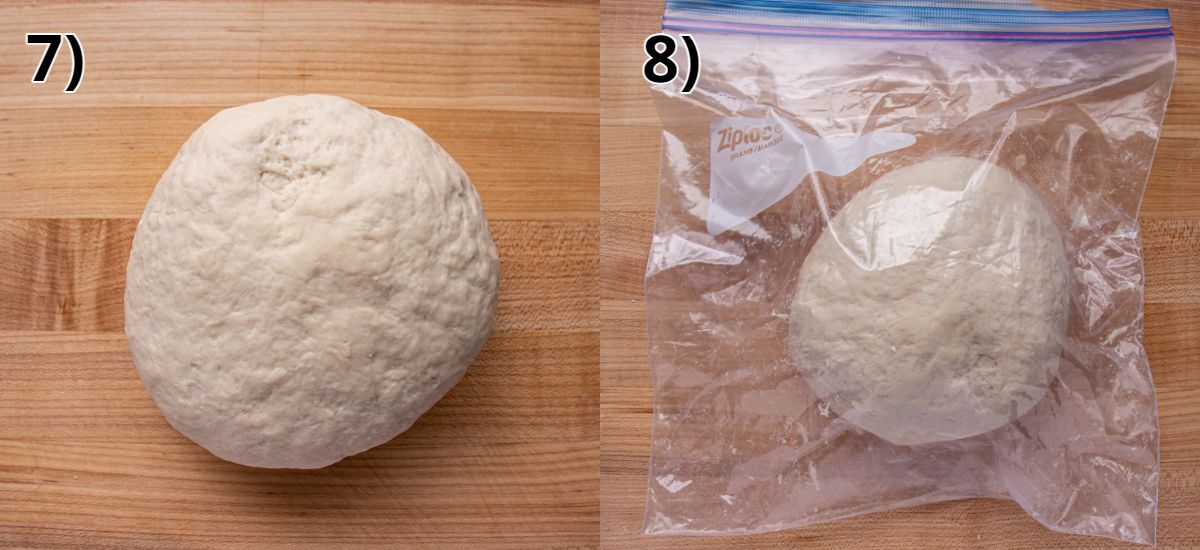
Rolling and cutting instructions
On a floured surface, place the ball of rested dough and lightly dust the top with flour.

Use a rolling pin to roll the dough, lightly dusting with flour if it threatens to stick to the pin or board, into a rough rectangle about ⅛-inch thick (mine was about 18 ½-by-13 ½-inches).
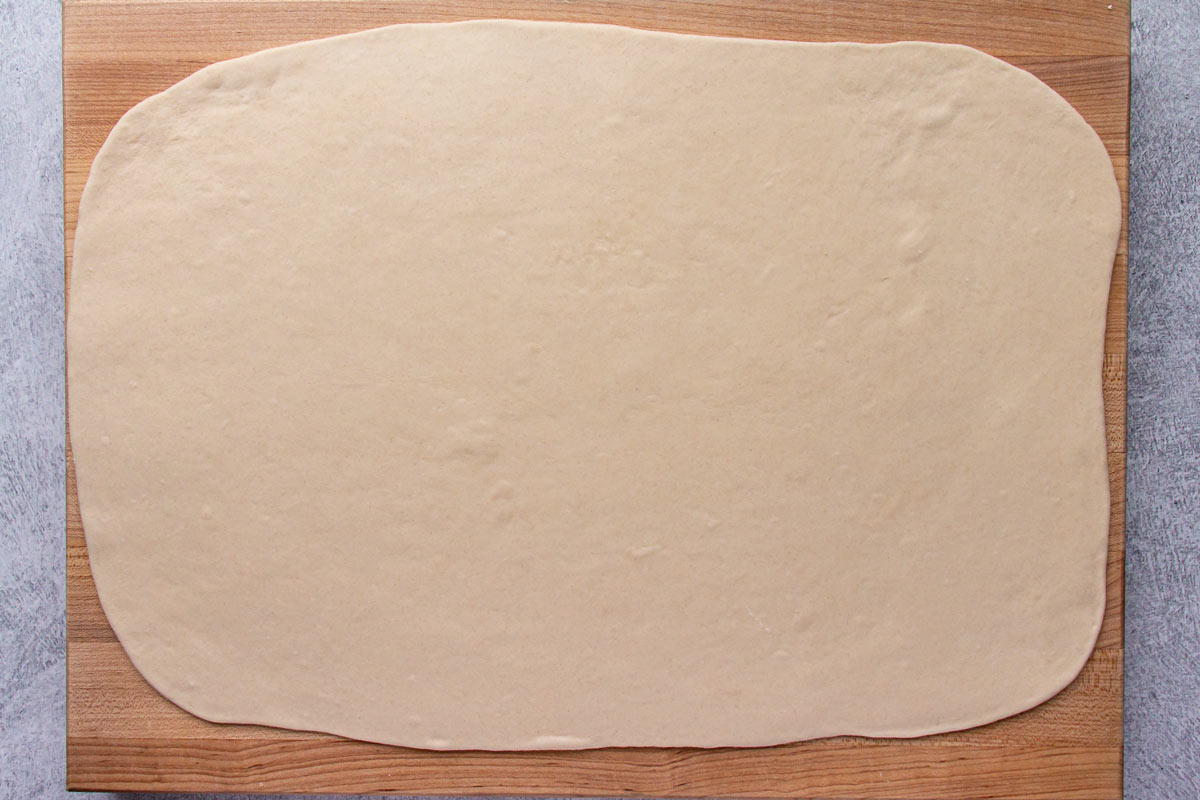
Make sure to roll out the corners of the dough to yield more of a rectangle than an oval. This way, when you cut the noodles, they will for the most part be equal lengths.
If you are having difficulty rolling, allow the dough to rest for 5 to 10 minutes as needed. This allows the glutens to relax and make it easier to roll out out.
Lightly dust the top again with flour, and then fold the dough into thirds to create a long strip.

Slice into approximately ⅛-inch-wide noodles.

Gently separate the noodles and toss them with flour so they don’t stick together. Cook or freeze immediately.

Cooking instructions
The way you cook homemade noodles is slightly different from the way you cook purchased noodles (which are already parboiled). Follow these instructions whether you’re planning to serve the noodles hot or cold.
Bring a large pot of water to a boil and prepare a large bowl of icy water. Add the noodles to the boiling water, stirring frequently and adding ¼ cup of fresh water if the water threatens to bubble over, until they’re fully cooked but not mushy, 10 minutes. (Unlike Italian pasta, they shouldn’t be al dente, but don’t let them get mushy.)
Drain the noodles, then transfer them to the icy water.

Briefly and gently rub them with your hands to remove some of the starch. Drain very well.
Please scroll to the bottom of the post for the full recipe (in a printable recipe card) including ingredient amounts and detailed instructions.

Expert tips
Portion out and freeze flour-dusted uncooked noodles for up to 1 month in a freezer-safe bag. Boil frozen uncooked udon (without thawing) for 12 minutes instead of 10 minutes. You can also boil, portion, and cool noodles, then freeze the pre-cooked noodles for 1 month in a freezer-safe bag.
If you're not freezing the fresh udon noodles, it's best to boil them shortly after making them, rather than refrigerating the uncooked noodles. Pre-cooked noodles will last for about 5 days in the fridge. To eat, just refresh them in boiling water for a minute or two, drain, rinse, and use.
Boiling homemade udon noodles in a generous amount of unsalted water serves a couple purposes. The noodles are less likely to stick together, and the ample amount of water helps to release most of the salt out of the noodles as they cook.
For best results, use a kitchen scale! This is one of my favorite kitchen tools, and it definitely helps with the accuracy in measuring the flour for homemade udon noodles. Measuring by volume can really impact the actual amount of flour since scooping can compact the flour into the cup.
Use a large 2-gallon Ziploc bag to knead the dough. If you only have 1 gallon bags (as I do in these photos), divide the dough in half and place one half in a 1-gallon Ziploc bag and knead each half separately (this is what I've done in the photos in this post). If you had to split the dough in half to knead it in a smaller bag, repeat kneading steps with the other half of the dough. Then place both halves of flattened dough on top of each other on your work surface, press gently to adhere them together, and then fold the edges underneath to form it into a single large smooth ball of dough.

How to substitute homemade udon noodles for store-bought
Most recipes calling for udon noodles use store-bought noodles. But how would you know how much udon to make or cook to yield the same amount you'd get in a package?
If we are comparing the homemade udon noodles to store-bought in terms of portion sizes, a 500 gram package (just over 1 pound) of store-bought parboiled udon noodles is usually considered in most recipes and instances to be 2 servings.
You can easily use a 1 pound package in the same way, since it's extremely close in weight and would really depend on where the store-bought udon noodles come from. Japanese brands would likely be 500 grams whereas a US-based brand like Twin Marquis would be 1 pound, which is 454 grams.
This homemade udon noodle recipe yields about 950 grams of raw udon noodles. After boiling and draining, this results in about 1550 grams of cooked udon noodles.
Again, assuming that roughly 500 grams of cooked udon noodles is 2 servings, then this entire recipe yields 6 servings. In this case, 1 portion uncooked is 150 to 160 grams and 1 portion cooked is about 250 to 260 grams.
Therefore, cook about 300 to 320 grams of raw udon noodles to yield approximately 500 grams of cooked noodles when a recipe calls for that.
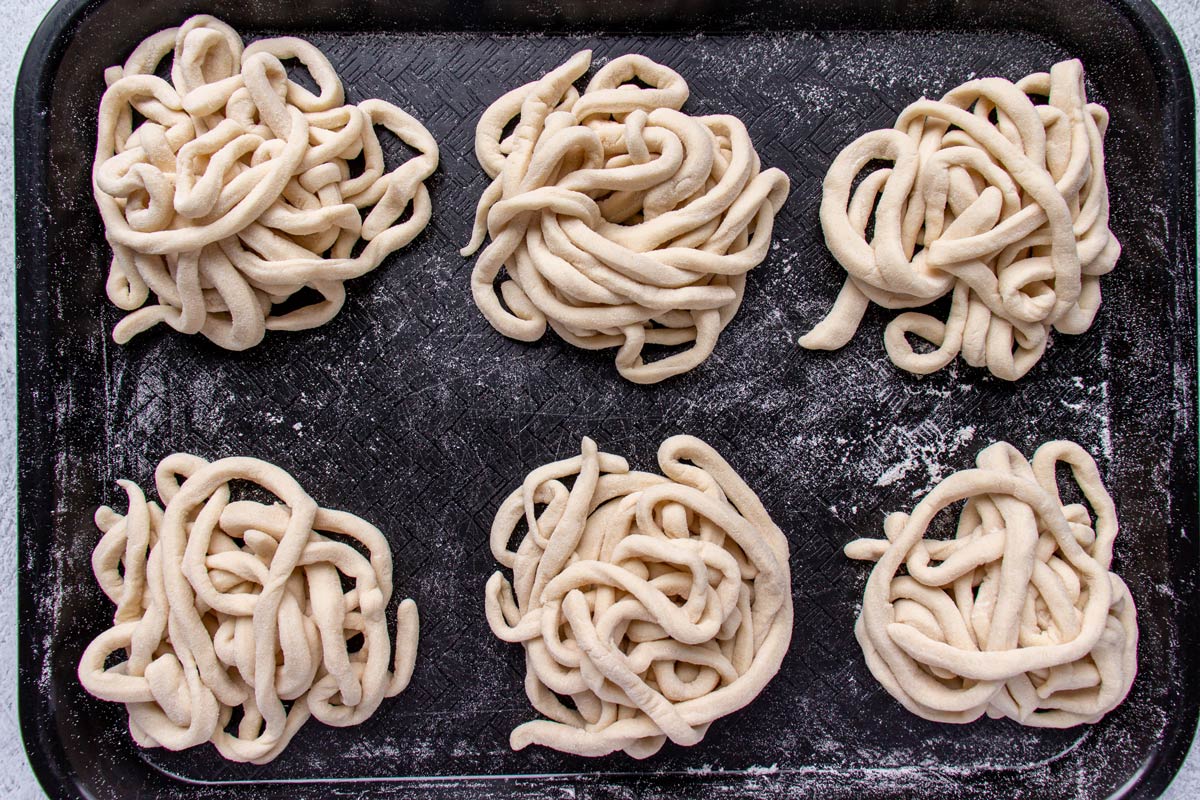
Other recipes you may like
- Yaki Udon (Japanese Stir-Fried Udon Noodles)
- Kare Udon (Japanese Curry Udon Soup)
- Beef Teriyaki Udon Noodles
- Japanese Curry Chicken Dumplings
- Ram-Don from Parasite (Jjapaguri with Steak)
- Japchae (Korean Sweet Potato Noodles with Meat and Vegetables)
- Pork Lo Mein
- Ants Climbing a Tree
- Pad Thai with Shrimp
Tried this recipe? Please leave a star ⭐️⭐️⭐️⭐️⭐️ rating in the recipe card below and/or a review in the comments section further down the page. You can also follow me on social media on Facebook, Instagram, and Pinterest!

Homemade Udon Noodles
Ingredients
- 600 grams (4 ¾ cups plus 1 tablespoon) all-purpose flour plus more for dusting and tossing
- 25 grams kosher salt (3 tablespoons Diamond Crystal brand or 1 ½ tablespoons Morton brand)
- 1 ¼ to 1 ½ cups filtered water
Instructions
- Combine the flour and salt in a large mixing bowl, stir, then add 1 ¼ cups of the water. Use your hands to mix until the dough starts to come together in shaggy mass.
- Start to firmly press and knead the dough, incorporating the loose flour until there’s none left. If necessary, add a little more water, 1 tablespoon at a time, until you can incorporate all of the flour. The dough should be very firm and still seem a little dry.
- Form the dough into a ball and place it inside a large 2-gallon Ziploc bag (or divide the dough in half and place one half in a 1-gallon Ziploc bag and do the following steps in batches with each half of the dough). Seal the bag leaving a small air gap at one end so air can still circulate as needed.
- Loosely wrap the bag in a kitchen towel and place it on the floor. Step on the bag with the dough inside and use your weight to flatten the dough. Use a rolling motion with your feet going from your heels to your toes, step on the dough about 50 times, rotating your body a few times to step evenly over all the dough. It will flatten out inside the bag.
- Carefully remove the flattened dough from within the bag (it may be a little stuck but just gently release it). Fold the dough into thirds and then fold it in half to make a square. Press to gently flatten, and then return the dough to the bag. Repeat the process of kneading with your feet (about 50 steps each) and then folding the flattened dough 2 more times. It should be a lot softer and more pliable than before.
- Remove the flattened dough from the bag after 3 times of kneading with your feet. If you had to split the dough in half to knead it in a smaller bag, repeat with the other half of the dough. Then place both halves of flattened dough on top of each other on your work surface, press gently to adhere them together. Fold the edges underneath to form it into a single large smooth ball of dough. Return the ball of dough to the Ziploc bag, seal it and let it sit at room temperature for 2 hours in summer or 3 hours in winter to allow the gluten to relax.
- On a floured surface with ample room, place the ball of rested dough and lightly dust the top with flour. Use a rolling pin to roll the dough, lightly dusting with flour if it threatens to stick to the pin or board, into a rough rectangle about ⅛-inch thick (mine was about 18 ½-by-13 ½-inches). If you are having difficulty rolling, allow the dough to rest for 5 to 10 minutes as needed. This allows the glutens to relax and make it easier to roll out out.
- Lightly dust the top again with flour, and then fold the dough into thirds to create a long strip. Slice into approximately ⅛-inch-wide noodles. Gently separate the noodles and toss them with flour so they don’t stick together. Cook or freeze immediately.
- To cook homemade udon: The way you cook homemade noodles is slightly different from the way you cook purchased noodles (which are already parboiled). Follow these instructions whether you’re planning to serve the noodles hot or cold.
- Bring a large pot of water to a boil and prepare a large bowl of icy water. Add the noodles to the boiling water, stirring frequently and adding ¼ cup of fresh water if the water threatens to bubble over, until they’re fully cooked but not mushy, 10 minutes. (Unlike Italian pasta, they shouldn’t be al dente, but don’t let them get mushy.)
- Drain the noodles, then transfer them to the icy water. Briefly and gently rub them with your hands to remove some of the starch. Drain very well.
Notes
- Portion out and freeze flour-dusted uncooked noodles for up to 1 month in a freezer-safe bag. Boil frozen uncooked udon (without thawing) for 12 minutes instead of 10 minutes. You can also boil, portion, and cool noodles, then freeze the pre-cooked noodles for 1 month in a freezer-safe bag.
- If you're not freezing the fresh udon noodles, it's best to boil them shortly after making them, rather than refrigerating the uncooked noodles. Pre-cooked noodles will last for about 5 days in the fridge. To eat, just refresh them in boiling water for a minute or two, drain, rinse, and use.
- For best results, use a kitchen scale! This is one of my favorite kitchen tools, and it definitely helps with the accuracy in measuring the flour for homemade udon noodles.
- This homemade udon noodle recipe yields about 950 grams of raw udon noodles. After boiling and draining, this results in about 1550 grams of cooked udon noodles.
- Assuming that roughly 500 grams of cooked udon noodles is 2 servings, then this entire recipe yields 6 servings. In this case, 1 portion uncooked is 150 to 160 grams and 1 portion cooked is about 250 to 260 grams. Therefore, cook about 300 to 320 grams of raw udon noodles to yield approximately 500 grams of cooked noodles when a recipe calls for that. You can divide up your noodles accordingly.
- Adapted from Mastering the Art of Japanese Home Cooking
Nutrition
*All nutritional information is based on third-party calculations and should be considered estimates. Actual nutritional content will vary with brands used, measuring methods, portion sizes and more.*


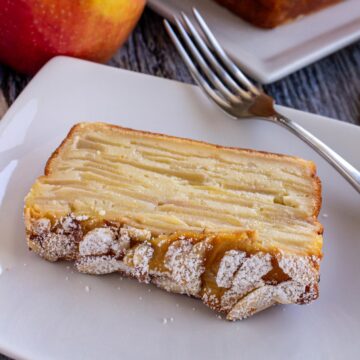



Comments
No Comments